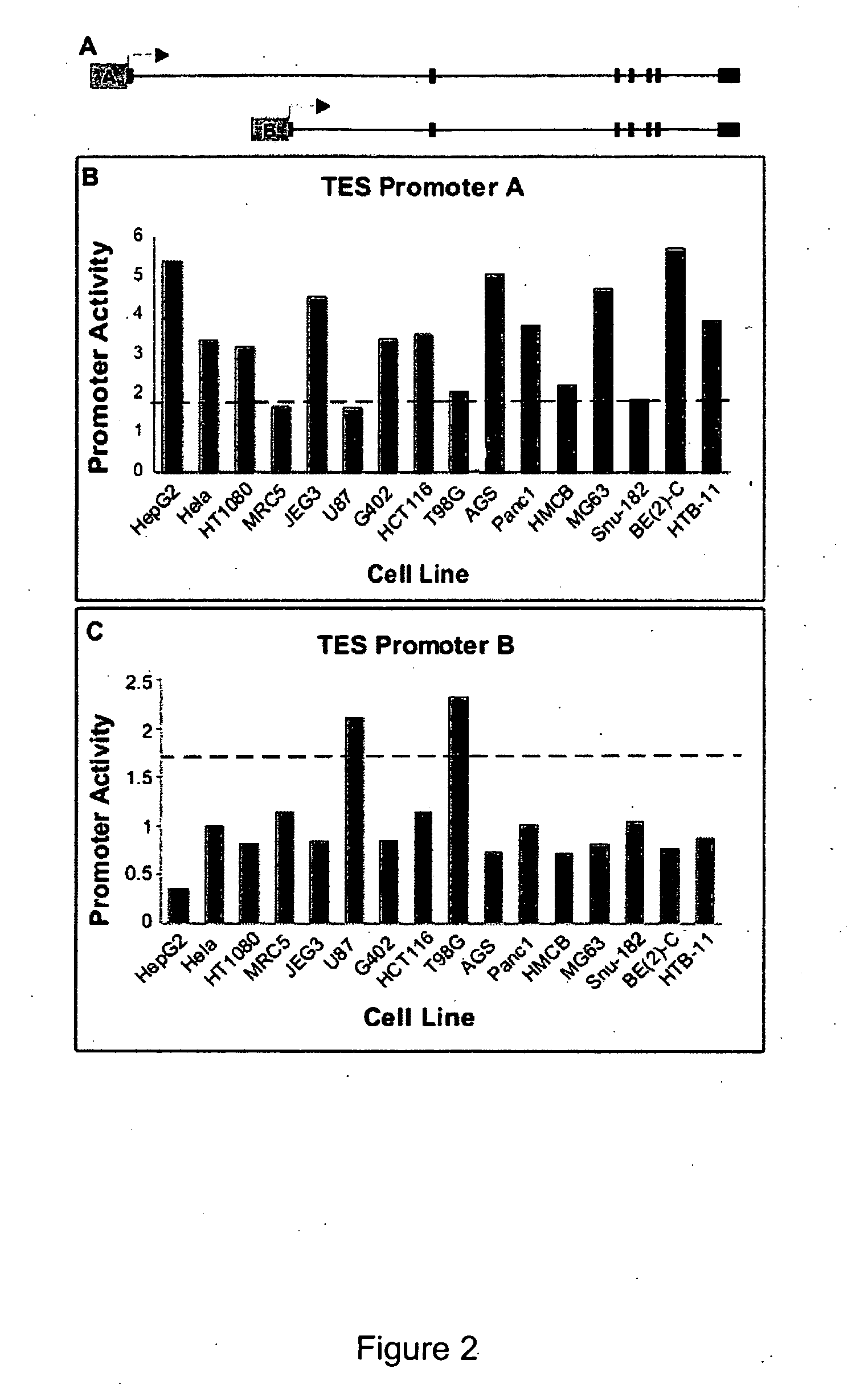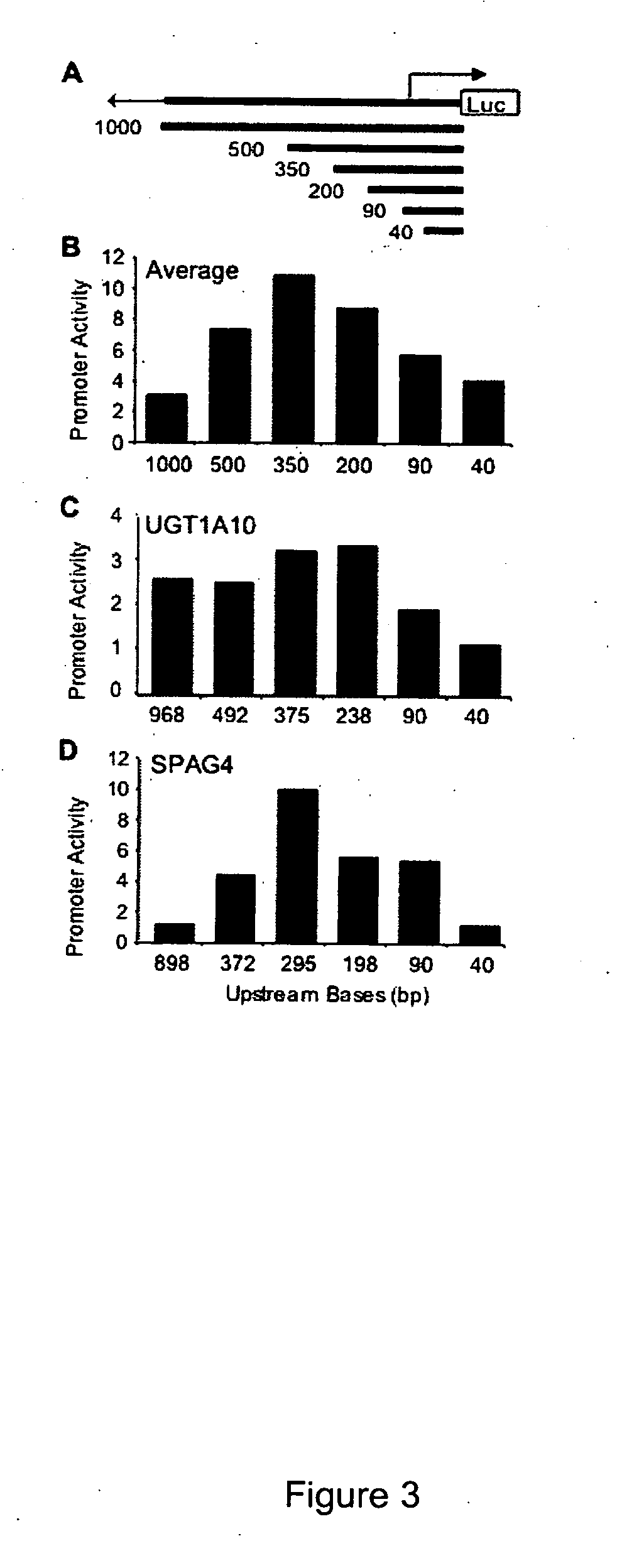Functional arrays for high throughput characterization of gene expression regulatory elements
a technology of gene expression and regulatory elements, applied in the field of functional arrays for high throughput characterization of gene expression regulatory elements, can solve the problem of not directly measuring the function of dna regulatory elements, and achieve the effects of reducing side effects, high throughput, and enhancing therapeutic efficacy
- Summary
- Abstract
- Description
- Claims
- Application Information
AI Technical Summary
Benefits of technology
Problems solved by technology
Method used
Image
Examples
example 1
Prediction and Transcriptional Assays of Putative Human Core Promoters in 1% of the Human Genome
[0211] In this example, several important biological questions regarding promoter function were addressed. The correlation of endogenous transcript levels and promoter activity for a sample of genes were calculated. While other transcriptional regulatory elements such as enhancers, silencers and insulators all modulate the function of promoters and affect steady state RNA levels in vivo, the contribution of promoters was quantified and demonstrate that in many cases promoters play a key role in controlling RNA levels.
[0212] The promoter activities of deletion constructs for a set of 45 promoters, allowing the identification of core promoter elements and other elements within the extended promoter that contribute to regulation of transcription initiation were studied. Finally, identification of significant overlaps between functional promoter regions and binding of TBP-associated factor ...
example 2
Large-Scale Structural and Functional Characterization of Human Expanded Promoters
1) Promoter Prediction Algorithm (PPA v1.2)
This example provides a preferred embodiment of the method illustrated in FIG. 9B.
A. Post-Processing of cDNA Alignments
[0254] As of Jul. 6, 2005, there were more than 200,000 human cDNA sequences aligned to the human genome (hg17) by the BLAT algorithm at UCSC. These alignments are all publicly available at the website of genome.ucsc.edu.
[0255] The PPA downloads these alignments and filters out those that have less than 95% sequence identity, those that have more than 200 bases at the 5′ end of the cDNA sequence that do not align to the genome, and those that align to random sequence not assembled into the reference chromosome sequences. These filters are implemented to remove cDNAs that have low quality sequence at the 5′ end and, therefore, predict dubious transcription start sites. As of Jul. 6, 2005, there were 223,100 cDNAs that met these criteria...
example 3
Assay for Determining DNA Methylation Status Genome-Wide
[0303] This example provides a preferred embodiment of the method for determining DNA methylation illustrated in FIG. 13. The process is as follows.
[0304] From either tissue culture cells or tissue samples, prepare high-molecular weight DNA using either a DNA affinity column (such as those provided in the DNeasy Kit from Qiagen) or by repeated phenol-chloroform extractions. Make sure the 260 / 280 ratio is >1.8 and that there are no residual traces of phenol in the sample.
[0305] Next digest 10 ug of the genomic DNA with 2 ul each of the following 3 methyl-sensitive restriction enzymes: HpaII, HgaI, HpyCH4 IV. Perform digestion in a total volume of 100 ul for 2-4 hours. These enzymes are optimized to work in the same buffer conditions (NEB Buffer #1) that is provided by the enzyme supplier (NEB).
[0306] Purify the DNA from the digest using the DNeasy columns from Qiagen. Elute in a final volume of 85 ul of water. Use this eluti...
PUM
| Property | Measurement | Unit |
|---|---|---|
| size | aaaaa | aaaaa |
| size | aaaaa | aaaaa |
| concentrations | aaaaa | aaaaa |
Abstract
Description
Claims
Application Information
 Login to View More
Login to View More - R&D
- Intellectual Property
- Life Sciences
- Materials
- Tech Scout
- Unparalleled Data Quality
- Higher Quality Content
- 60% Fewer Hallucinations
Browse by: Latest US Patents, China's latest patents, Technical Efficacy Thesaurus, Application Domain, Technology Topic, Popular Technical Reports.
© 2025 PatSnap. All rights reserved.Legal|Privacy policy|Modern Slavery Act Transparency Statement|Sitemap|About US| Contact US: help@patsnap.com



